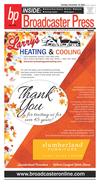032619_YKBP_A11.pdf





Broadcaster Press 11
March 26, 2019 www.broadcasteronline.com
MARCH 2019
BY TYLER MANN
H
VERMILLION.K12.SD.US
VERMILLION HIGH SCHOOL’S STUDENT NEWSPAPER
DAYDREAM NATION
ere it is. My personal big one. My favorite piece of media of all time ever. Sonic
YouthÕs 1988 double album, Daydream
Nation. But why is it my favorite? Well, I like it
more than anything else. Unfortunately, that isnÕt
an interesting explanation. I instead will chronicle my love for Daydream Nation in a verbose
and lengthy manner, with the paragraphs divided
based on the instrumentals first, and vocals and
lyrics second.
This is an extremely visceral album, and
is best enjoyed while darting down the highway
at 70 miles per hour. The pure speed and loud,
noisy sonic scope of the opening tracks, ÒTeen
Age RiotÓ, and ÒSilver RocketÓ lend themselves
best to this. The former is 80Õs alt rock in its purest form, with the jangly opening giving way to a
speedy riff, with itÕs carefree attitude never leaving throughout its seven minute runtime. ÒSilver
RocketÓ, along with ÒCross The BreezeÓ, show
the crux of the albumÕs sound. This album fuses
punk aggression with noisy, avant-garde soundscapes in the most perfect way. ÒEricÕs TripÓ and
ÒHey JoniÓ are the most accessible songs on the
album, because despite keeping with Thurston
Moore and Lee RanaldoÕs rabid guitar noise, they
both have fairly typical pop structures, while the
song they sandwich, ÒTotal TrashÓ, has no typical
structure at all. It opens with a couple of verses,
before launching into four minutes of thrashy guitars sounding like jackhammers and the painful
cries of some alien species, before ending with
another verse (this time slowed down). The song
following this trio, ÒProvidenceÓ, is a necessary
calm moment for the album. It consists of three
factors: a downtrodden piano track, a guitar amp
hissing, and the recording of a voicemail from
a friend of the bandÕs. These factors combine
to make an ambient and quite beautiful piece of
work. The beauty continues with the opening guitar arpeggios of the following song, ÒCandleÓ.
However, the chaos returns soon enough in a glorious way in the songÕs breakdown. ÒRain KingÓ
is the bleakest moment on the album with the
heavy guitars sounding like the music for some
nuclear wasteland, and the relentless drums never
giving up their pace. To close out the album is
ÒTrilogyÓ a 14 minute epic with three distinct sections, the first two being freewheeling and long
winded, and the third being tense, short and the
most clear homage to punk on the album.
Instrumentally, the album sounds uncalculated, despite being so. Vocally and lyrically,
however, the album sounds uncalculated, most
likely because it was. Moore and Ranaldo talk
with the slightest hint of melody, although on
some songs like ÒCandleÓ, Moore adds a boyish
strain to his voice which comes off well. Bassist
Kim Gordon grunts and moans her way through
her songs. SheÕs at her most primal on ÒThe
SprawlÓ and ÒCross The BreezeÓ, both of which
she sounds furious on. These vocal styles, particu-
larly GordonÕs, are off putting for some but I enjoy them as they fit the rawness of the music perfectly. Lyrically, itÕs clear their words are not the
bandÕs main focus. Gordon is the most authentic
in this regard, with her best moment being ÒKissabilityÓ, a track about the problems women face
in the entertainment industry. On the flip side,
Moore and RanaldoÕs tracks seem to lack a strong
point, and instead aim to play with the English
language and how words sound. If anyone can
tell me the message or story in songs like ÒTotal
TrashÓ or ÒRain KingÓ, it would be greatly appreciated. However, each have a couple songs with
clarity. ÒTeen Age RiotÓ, the Moore led opener, is
about just that, and RanaldoÕs ÒEricÕs TripÓ details
a bad acid trip and borrows lyrics from an Andy
Warhol film.
Daydream Nation can be quite a challenging album upon first listen, with its long runtime
and noisy, suffocating demeanor; pushing through
that initial challenge is wholly rewarding, and after that Daydream Nation can be unearthed as one
of the greatest albums to be recorded in rock history.
Report Card
Composition: A+
Performances: A+
Production: A+
Lyrics: A+
Listen on YouTube!
Album Label: Enigma; October 18, 1988
WORDFIND
BY LILLIAN MOCKLER
Your future is waiting.
Make it happen.
Schedule your campus visit today at the region’s best
two-year technical college: southeasttech.edu/visit.
Jumpstart your college education with Dual Credit:
southeasttech.edu/dualcredit.
605.367.6040 | SOUTHEASTTECH.EDU
Cards +
Magic
out-joggin (see QR code for a
more in depth description of in
in-joggin nÕ out-joggin).
After jogging, take the four
cards you have Ôout joggedÕ
and show them to the spectator.
Ask them if their card is one
of the four spectatorÕs cards.
If they say yes, put those four
cards on top of the four cards
in your opposite hand. If they
say no put the four cards on the
bottom of the ones in your opposite hand.
Step two is essentially repeating the beginning. If they say
no, put the cards on TOP of the
pile in your opposite hand. If
they say yes, put them on the
BOTTOM of the cards in your
opposite hand.
Step three is, again, the same
as step one. If you donÕt understand, use the QR code at the
bottom of the article. Now after you have done those steps
youÕre going to deal the cards
from left to right into two piles.
Now itÕs helpful to have three
questions prepared so you can
ask the person what their card
is. The first question I typically
use is, ÒIs your card a king or
a queen?Ó Flip the right pile
over and reveal if it was a king
or a queen. Then ask for confirmation from your spectator.
Now take the left pile and deal
WITH NATE
BOHNSACK
T
he second card trick of this
series is a prediction card
trick. This trick only involves
eight out of the fifty-two cards.
The first step is to take out all
the kings and all the queens.
Separate the kings and queens,
then place them in CHaSeD
order. CHaSeD order is an
acronym for Clubs, Hearts,
Spades, and Diamonds. After
putting the cards in CHaSeD
order, youÕre going to put the
cards face up and put the kings
on top of the queens.
Once youÕve done that, youÕre
going to fan the cards out and
have your spectator memorize
any one card. After they have
done this you are going to do
what is called in-joggin nÕ
it out from left to right into
two more piles. Then ask your
second question; my question
usually is ÒIs your card black
or red.Ó After you have asked
the question, flip the right pile
over. Ask the spectator for
conformation on if the cards
are right.
Now, youÕre going to take the
left pile and move the top card
to the left. Commence to ask
your question. Depending on
what the color is, I ask if their
card is a heart or diamond, or
if their card is a spade or club.
After asking the question,
turn over the pile on the right.
There should be only one card
face down. Ask them what
their card was and after they
tell you, flip the final card over
and youÕre done.
Prepare to amaze your spectators. Magic awaits!
Follow along with MagicNate on a
video tutorial by following the QR
code below:
COMIC
BY KEEGAN RETZLAFF
Reyanna Felicia

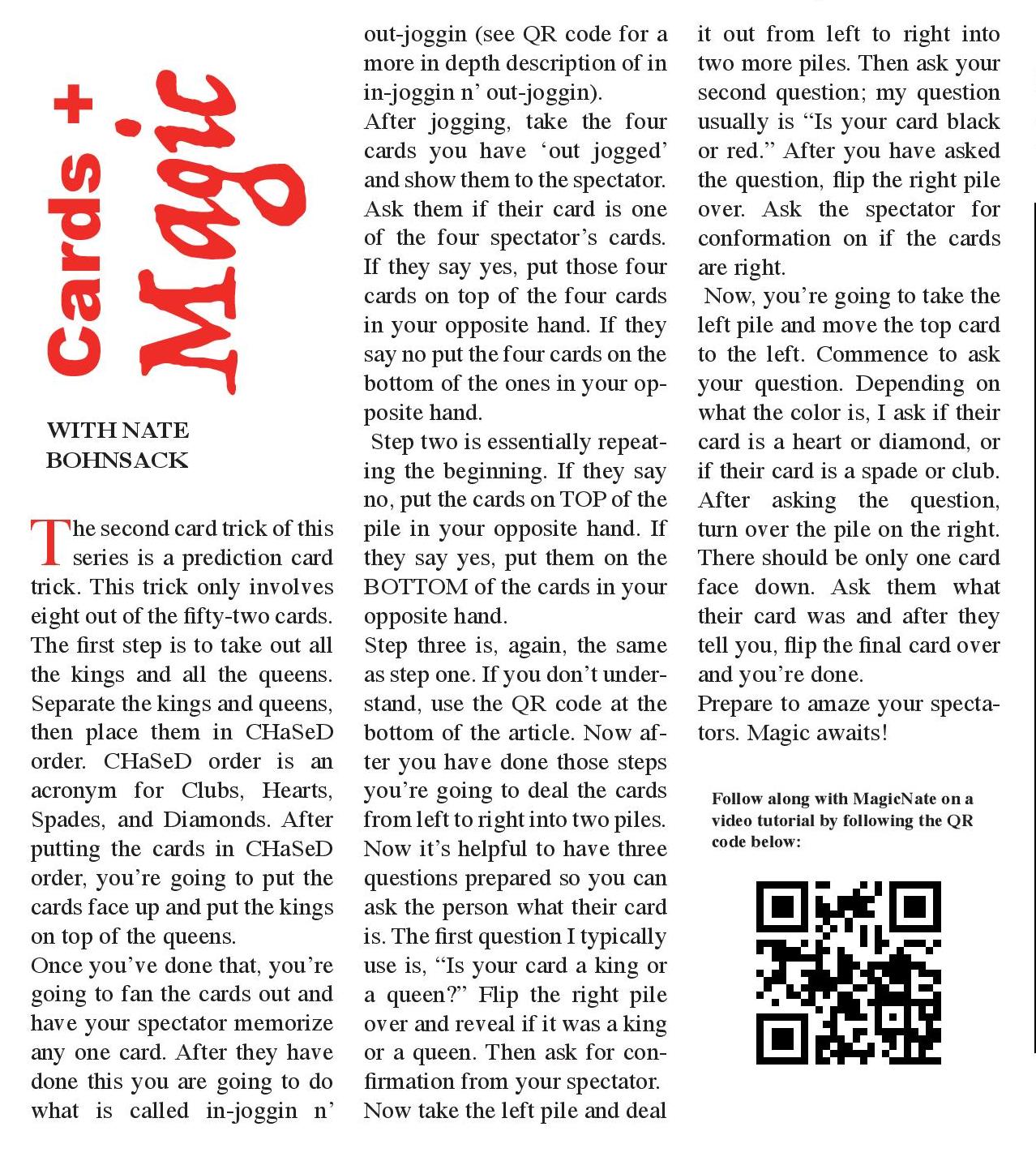

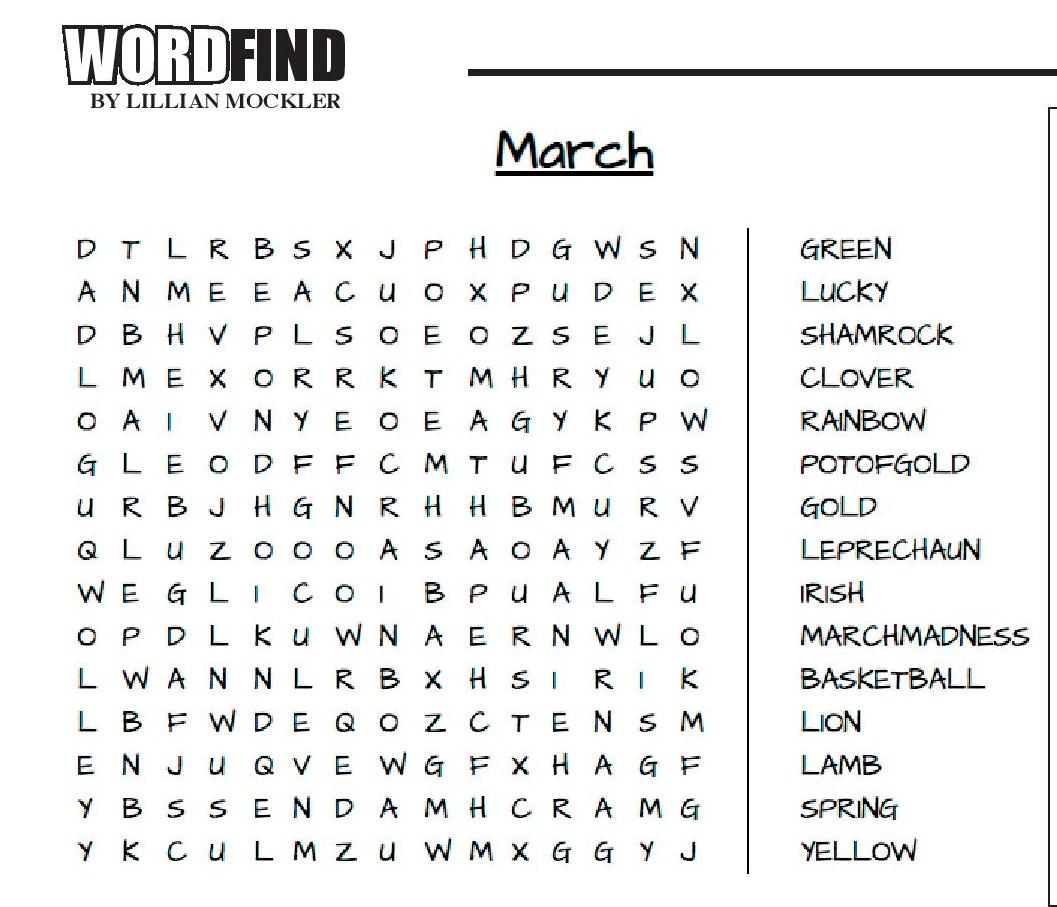





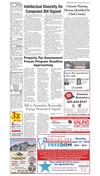
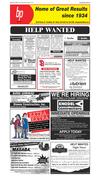
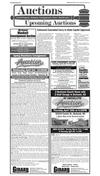

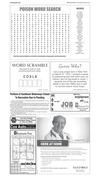
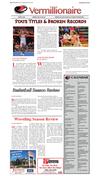
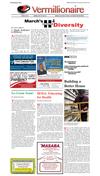
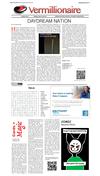

 Previous Page
Previous Page





